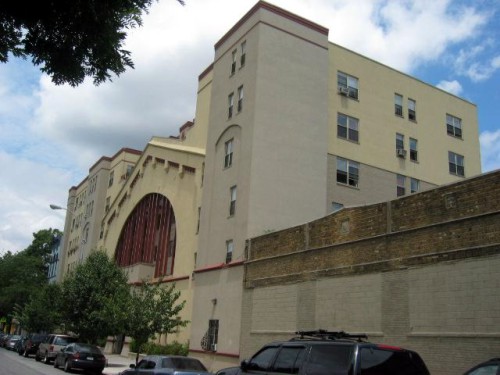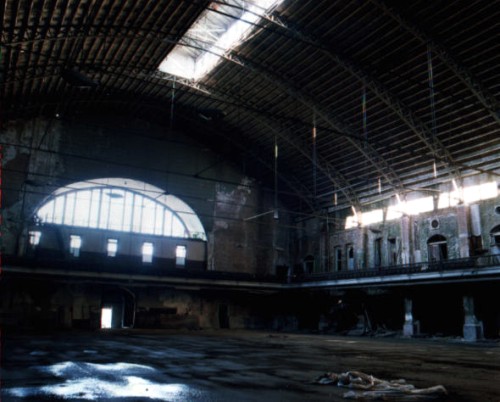Building of the Day: 171 Clermont Avenue
Brooklyn, one building at a time. Name: Formerly Clermont Armory, now Clermont Armory Apartments Address: 171 Clermont Avenue Cross Streets: Willoughby and Myrtle Avenues Neighborhood: Fort Greene Year Built: Original building built in 1873. Radically altered in 1911, again radically altered in 1995 Architectural Style: Originally Second Empire, 1911 alterations in Neo-Medieval style. Architect: William Mundell,…

Brooklyn, one building at a time.
Name: Formerly Clermont Armory, now Clermont Armory Apartments
Address: 171 Clermont Avenue
Cross Streets: Willoughby and Myrtle Avenues
Neighborhood: Fort Greene
Year Built: Original building built in 1873. Radically altered in 1911, again radically altered in 1995
Architectural Style: Originally Second Empire, 1911 alterations in Neo-Medieval style.
Architect: William Mundell, original building, Floyd Peterson in 1911, Robert Scarano in 1995
Other Work by Architect: Mundell – Williamsburg and Park Slope armories, old Pouch Mansion and Brooklyn Hall of Records, both no longer standing.
Landmarked: No
The story: The Clermont is Brooklyn’s oldest standing armory building. It was built for the 23rd Regiment, founded in 1861, during the Civil War. They were an offshoot of the 13th Regiment, headquartered on Flatbush Avenue, and broke off to become an independent regiment. When the regiment came back to Brooklyn after the war, they were housed in the old Gothic Hall, on Adams Street, an 1830s building that had been retrofitted for their use. It was too small, and not really set up to be a real armory, so in 1871, the 23rd’s commander, Rodney C. Ward, lobbied the city and state for funds for a new armory building. In 1872, the cornerstone was laid, here on Clermont Avenue.
The building was a Second Empire style armory, with an administrative wing more reminiscent of a large school, with a central mansard roofed tower. It was designed by William Mundell, who would have three armories in his portfolio, this one, as well as the 47th Regiment Armory in Williamsburg, begun in 1883, and later in 1891, the 14th Regiment Armory in Park Slope.
Behind the administrative façade lay the real reason for an armory, a large drill shed where the unit could practice marching and formations, battle strategies and have military drills and parades. Mundell outdid himself here, with a large hall of 130×180 feet, with 130 foot iron trusses spanning the width of the hall. At the time, it was the largest hall without pillars or obstructions in the US. The 23rd took possession of the armory with great pomp and circumstance on Sept. 30, 1873.
In 1895, the 23rd left the Clermont Armory for their even newer and larger digs at their new state-funded armory on the corner of Bedford and Atlantic Avenue. In 1911, architect Floyd Peterson was brought in to modernize the Clermont, as it was now Brooklyn’s oldest remaining armory structure. He tore down Mundell’s Second Empire façade, and made over the front in what was called the Neo-Medieval Style. Although the drill hall remained virtually untouched in this renovation, the front entrance and administrative wing of the armory were given a dramatic makeover, transforming it into a rather grim concrete clad fortress. The armory remained a National Guard unit until 1964.
After that, the city took over the building, and used the drill shed as a storage garage and warehouse for the Sanitation Department. The administration end of the building was not really utilized, and the facility began to suffer the inevitable deterioration that seems to mark all of New York City during this period. Sanitation called it quits in 1989, and just let the building sit there.
Vandals broke in and stole everything of worth, including all of paneling and furnishings in the officer’s quarters, the mantelpieces, lighting, and anything else that was left. They also stole all of the copper pipes and waterproofing, gutters and drains, leaving the building further unprotected from water damage. Naturally, after that, the roof was in bad shape, and the building was a derelict shell.
In 1995, developers bought the building at public auction and transformed it into housing. It was a part of the city’s New Opportunities Program, a part of the Housing Development Corporation. This program was also developing new housing at the Knox Hat Factory in Crown Heights and at the old furniture warehouse at Emerson Place, near Pratt Institute. The up and coming firm of Scarano Architects, PLLC, was chosen to undertake the transformation of a huge building with no interior light into apartments.
Scarano punched a lot of holes for windows back and front, and then put a courtyard in the middle of where the drill shed was, and more windows were set in to allow light to enter all of the rooms in the new apartments. The courtyard is a great touch, and utilizes three of the original trusses from the original drill shed. They still span the width of the original shed, and give one a good idea of how large this shed originally was. He also squared off the back allowing for even more apartments. The original arched roofline of the armory is outlined in concrete, with several windows cleverly inset into the archway. The new building, appropriately called the Clermont Armory, now houses 111 units, ranging from studios to three bedroom apartments. It’s a good reuse of a large building with a great history. GMAP
(Photo: Sara Westcott for PropertyShark)






.






What's Your Take? Leave a Comment